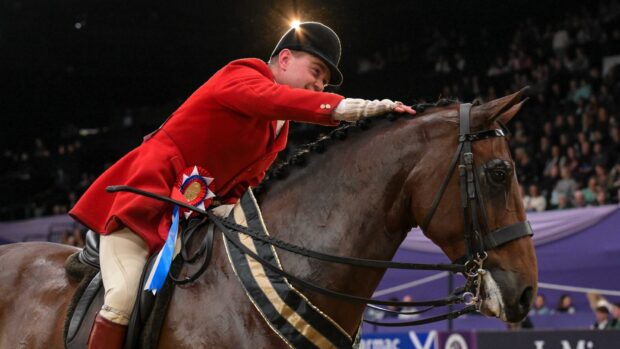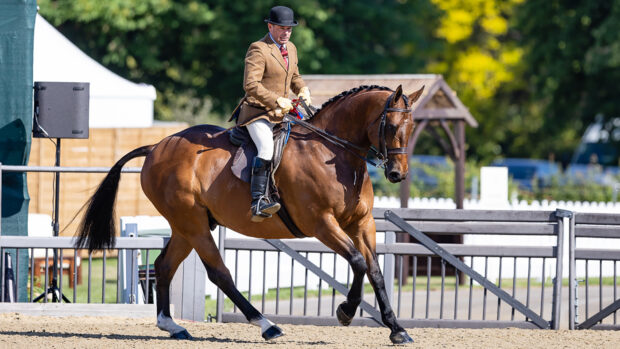This week’s guest editor on combating nerves, the secret ingredient that makes his horses shine and dealing with naughty mounts in the ring.
Q. What is going through your mind when you’re in the ring? How do you combat any nerves?
A. “Everybody suffers from nerves at some point and I’m no exception, especially if I’m riding the hot favourite at Horse of the Year Show [HOYS] and there’s quite a bit of pressure. I find that once I’m in the ring my mind is on the job and because I’m focused nerves aren’t a problem. Waiting around is never easy, and sometimes I might joke around with the rest of my team to lighten the atmosphere. Some people thrive off adrenalin and that nervous energy, and I’ve just learned to deal with it.”
Q. I’ve acquired an ex-racer to show at local level. He’s six years old and still relatively new to metal bits. How soon would you introduce a young horse to a Pelham and/or a double bridle? I don’t want to rush and upset him, as we’re a new combination.
A. “There is no pressure to ride in a bit with a curb chain, whether it’s a Pelham or a double. The main thing is to work on softening and suppling your horse while he’s wearing the snaffle, in order to encourage him to take a softer contact. When you feel he’s ready, a good first option would be a jointed Pelham, because it’s less of a change for the horse, which makes it easier to start with. With any bit change it’s about taking the time to make sure your horse is really happy and comfortable in its mouth before you progress.”
Q. What is in the bucket and sponged onto your horse before going into the ring to give that magnificent shine?
A. “I could tell you my secret but I’d also have to kill you! It’s a pain to carry several different things around at a show, so we mix coat gloss and glistening oil with a drop of warm water. It’s applied just before the horse goes into the ring and in the sun or under spotlights it creates extra shine.”
Q. My five-year-old Irish Draught has the bone of a heavyweight, but at 16.2hh she isn’t tall enough for those classes — what class would you advise showing her in?
A. “I suggest middleweight classes. Irish Draught classes are so popular now and she would be dwarfed in a heavyweight line up. No horse can have too much bone so I wouldn’t say it’s a disadvantage to be in a middleweight class with all that bone.”
Continued below…
| *Sponsor’s message* When TopSpec Comprehensive Feed Balancer is fed there is therefore often no need to add any further supplements, other than salt or electrolytes for sweating horses. The addition of e.g. blood tonics, yeast supplements/digestive aids, or hoof supplements is usually an unnecessary expense, ineffective and potentially harmful. Keep up to date with all the latest news from TopSpec on Facebook |
Q. If a horse misbehaves in the ring, how do you cope with it?
A. “I work on the theory that the work is done at home. Fresh horses learn bad habits so make sure they arrive at a show having had plenty of work in the lead up, which will help them to be relaxed rather than on their toes.
I do everything I can to prevent a horse being naughty — that might mean using cotton wool to block the ears of a horse who gets anxious and nervous, so that they are less sensitive to noises around them.
If I have a horse with a particular problem — for example he bucks in the gallop — I would teach him to lengthen at home. Practice really does make perfect.
You also need to make sure your horse respects and trusts you. Before you go to a show make sure you can manage them on ground and when ridden.”
Q. Of all the horses you’ve shown, who stands out in your mind as the best and why?
A. “There’s been so many great ones that it’s hard to choose. The most correct horse I’ve ever had was the middleweight hunter Pride & Joy (pictured). His conformation and looks were perfect and he won at HOYS three years on the trot. Was he the best show horse? I can shortlist three for that — the lightweight hunter Royal Flush, large riding horse Broadstone Doulton — he stood supreme at HOYS too — and the heavyweight cob So Smart. Those three loved their job and wanted to do it so badly — even if they weren’t the best in the ring they absolutely wanted to be and sometimes having that attitude is the bigger advantage.”
Q. I’m a big fan of Starry Night — how is he getting on in his retirement?
A. “His owner Camilla Neame regularly posts photos of ‘Basil’ out hunting — he loves his new life and is doing really well. It’s fantastic that these horses can go on to do something else.”
Q. My horse is quite lazy. What sort of thing would you recommend doing in the warm up to get the best from him in the ring?
A. “If I’ve got a horse who is lazy I rarely ride it in a sand school. I try and vary their work between hacking and schooling in open fields instead. Some horses switch off the moment they walk through a gate into a school, and they find it easier — and more enjoyable — to learn by working in a field. They need to think forward and that comes from enjoying what they’re doing. If you can get your horse happy at home it will transfer to the show ring.
My lightweight hunter Hitman hated working in an arena. He would go nicely in one at a show, and went on to win at RIHS, but he found it too boring at home so we always went in the field.”
Q. Do you hunt your show horses?
A. “I have done in the past because it is a great way to educate a horse. Asking different questions and giving them a broader spectrum in life is important and horses that hunt are better educated.
Personally I don’t hunt my show horses as much now compared to when I lived in Yorkshire. It gets very wet here in Cheshire and it’s fast hunting country. To educate a show horse you need to be able to teach them without blemishing them or blowing their brains.”
Continued below…
Like this? You might also enjoy reading these:
5 horses Robert Walker would like to pinch for the show ring
Sneak a peek at showing supremo Robert Walker’s yard *PICTURES*
11 things you didn’t know about showing star Robert Walker *VIDEO*
Q. When you go to view a horse, what attributes are you looking for?
A. “First and foremost I’ve got to want to take it home, so it must make a good first impression on me. That’s what a judge will see when I ride them into the ring, so it’s important. Secondly I look for good conformation — if they don’t have this, they won’t do well in the ring.”
Part two of Robert’s Q&A will be on horseandhound.co.uk tomorrow (Wednesday 16 March) evening.
Don’t forget to buy this week’s showing special, guest edited by Robert Walker, on sale 17 March




